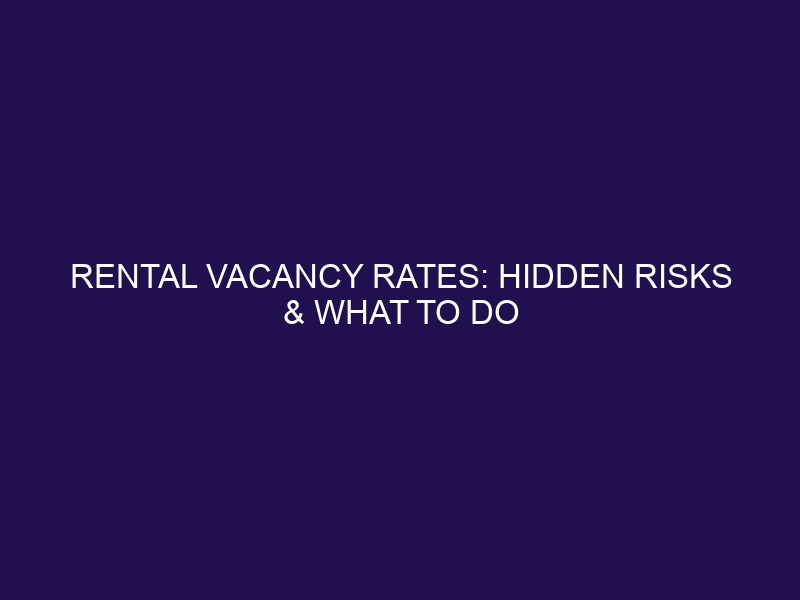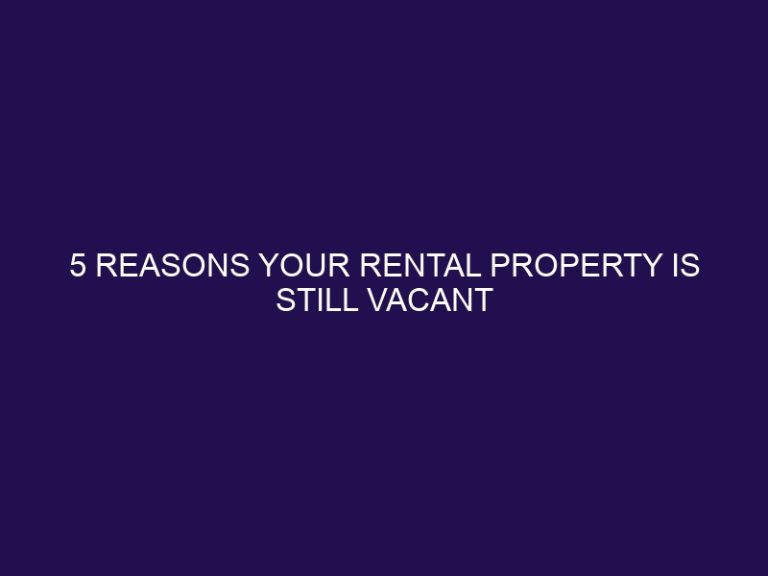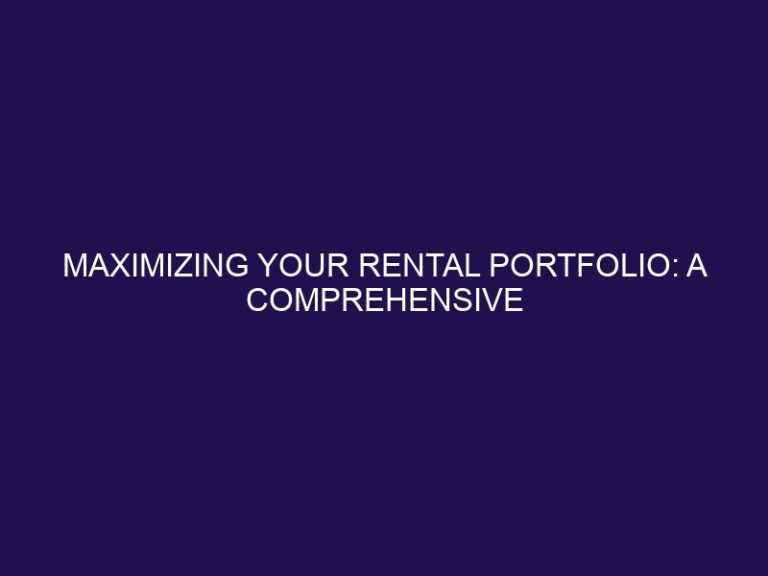Rental Vacancy Rates: Hidden Risks & What To Do About Them
Rental vacancy rates refer to the percentage of unoccupied rental properties in a given area. This metric is used to track the demand for rental properties and can have a significant impact on landlords, property values, and tenants. Understanding rental vacancy rates and the associated risks can help landlords make informed decisions about their rental properties.
Rental vacancy rates are important because they directly impact the rental income, property value, and tenant quality for landlords. A high vacancy rate can signal a lower demand for rental properties, resulting in lower rental income and potentially affecting the value of the property. Additionally, a lower tenant demand can make it challenging to find high-quality tenants, leading to potential property damage and a decrease in the overall value of the property.
Rental vacancy rates are calculated by dividing the number of vacant rental units by the total number of rental units in a given area. This calculation is typically done on a quarterly or yearly basis to track changes in demand over time.
A “healthy” rental vacancy rate is generally considered to be around 5%. This indicates a balanced market, with a steady demand for rental properties and a manageable number of vacancies. Higher vacancy rates, above 10%, can indicate an oversaturated market with an excess supply of rental properties.
High rental vacancy rates can pose hidden risks for landlords. These risks include decreased cash flow, increased risk of property damage, and difficulty finding quality tenants. With fewer tenants to generate rental income, landlords may struggle to cover their expenses and experience a decrease in cash flow. Additionally, vacant properties can be more susceptible to vandalism and theft, leading to property damage and financial losses. Moreover, a lower demand for rental properties can make it harder to find high-quality tenants, increasing the risk of property damage and potential eviction costs.
To address high rental vacancy rates, landlords can take proactive measures such as offering incentives to attract tenants, improving property management and maintenance, and adjusting rental prices to align with market demand. By offering perks such as rent discounts or free utilities, landlords may entice potential tenants to choose their property over others. Additionally, maintaining and improving the property’s condition can make it more attractive to potential tenants and mitigate the risk of property damage.
In conclusion, understanding rental vacancy rates and the associated risks is essential for landlords to make informed decisions about their rental properties. By actively monitoring and addressing high vacancy rates, landlords can mitigate risks and maintain a healthy rental property business.
Key Takeaways:
What Are Rental Vacancy Rates?
Rental vacancy rates refer to the percentage of available rental units in a specified area. This information is used to measure market conditions and can impact rental income and property values. In order to combat high vacancy rates, landlords may offer incentives such as rent discounts or property upgrades to attract potential tenants.
Why Are Rental Vacancy Rates Important?
Rental vacancy rates may seem like a minor detail in the world of real estate investing, but they can actually have a significant impact on your rental property. In this section, we will discuss the importance of understanding and monitoring rental vacancy rates. We will delve into how these rates can affect your rental income, property value, and even the quality of your tenants. By recognizing the hidden risks associated with rental vacancy rates, you can take proactive steps to mitigate their potential negative impact.
1. Impact on Rental Income
- Decreased income due to unoccupied units and the impact on rental income
- Financial strain from covering property expenses
- Reduced ability to invest in property improvements
2. Impact on Property Value
- Influence on property appreciation or depreciation.
- Affects demand for rental properties, impacting overall property market and potentially leading to changes in property value.
- Can lead to decreased property value if vacancy rates remain high.
3. Impact on Tenant Quality
- Thorough tenant screening processes help maintain the quality of tenants.
- Implementing background checks and reference verifications ensures reliable tenants and has a positive impact on tenant quality.
- Regular communication and promptly addressing concerns fosters positive tenant-landlord relationships, which also contributes to a harmonious rental community.
Did you know? Quality tenants have a significant impact on the overall tenant quality within a rental community.
How Are Rental Vacancy Rates Calculated?
- Gather Data: Count vacant units and total units available for rent.
- Calculate Rate: Divide the number of vacant units by the total number of units and multiply by 100 to get the rental vacancy rate percentage.
- Consider Time: Ensure data is collected for a specific period, such as monthly or annually.
What Are Considered “Healthy” Rental Vacancy Rates?
Healthy rental vacancy rates are typically considered to be between 5% and 7%. This range signifies a good balance, enabling landlords to easily find tenants without experiencing excessive turnover. Rates lower than 5% may result in heightened competition among potential tenants, while rates higher than 7% could indicate an oversupply of rentals and potential financial risks.
What Are the Hidden Risks of High Rental Vacancy Rates?
High rental vacancy rates can bring hidden risks for landlords and property owners. In this section, we will discuss the potential consequences of a high vacancy rate, including decreased cash flow, increased risk of property damage, and difficulty finding quality tenants. By understanding these risks, landlords can better prepare for and mitigate the negative impacts of a high vacancy rate on their rental business.
1. Decreased Cash Flow
- Review current rental market rates for similar properties.
- Consider offering move-in specials or discounted rent.
- Enhance property features or amenities to justify rent price.
During the 2008 financial crisis, many landlords experienced a decline in cash flow as tenants faced job losses.
2. Increased Risk of Property Damage
- Conduct regular property inspections to identify and address potential issues early.
- Invest in preventive maintenance measures to protect against the increased risk of property damage.
- Thoroughly screen tenants to minimize the risk of property misuse or neglect.
3. Difficulty Finding Quality Tenants
- Enhance Property Appeal: Renovate, upgrade amenities, and ensure cleanliness to attract high-quality tenants.
- Effective Marketing: Utilize various platforms, professional photography, and compelling descriptions to reach potential tenants.
- Thorough Screening: Implement rigorous background checks, credit assessments, and reference verifications to secure reliable tenants.
A property owner struggling with the challenge of finding quality tenants revamped their property, utilized social media for targeted marketing, and implemented a stringent screening process, resulting in successfully securing long-term, high-quality tenants.
What Can Landlords Do to Address High Rental Vacancy Rates?
As a landlord, high rental vacancy rates can be a major concern. Not only does it mean a loss of potential income, but it may also indicate underlying issues with the property or management. In this section, we will discuss proactive measures that landlords can take to address high rental vacancy rates. From offering incentives to attract tenants, to improving property management and maintenance, and even adjusting rental prices, we will explore various strategies to combat this challenge.
1. Offer Incentives to Attract Tenants
- Attract potential tenants by offering a discounted first month’s rent.
- Provide move-in bonuses, such as free parking or storage, to entice new tenants.
- Include utilities in the rent to make the property more appealing to potential tenants.
2. Improve Property Management and Maintenance
- Regular property inspections and prompt repairs
- Implementing effective maintenance schedules to improve property management
- Enhancing tenant communication for issue reporting and resolution
By addressing tenant concerns promptly, a landlord was able to improve maintenance and management, resulting in higher tenant satisfaction and reduced vacancy rates.
3. Adjust Rental Prices
- Assess local market rates and trends.
- Consider property amenities and location.
- Factor in maintenance costs and desired profit margin.
- Adjust rental prices competitively and periodically.
Frequently Asked Questions
1. What are some quick ways to reduce rental vacancy rates?
Landlords and property managers can reduce vacancy rates by researching the neighborhood, maintaining the property, pricing it competitively, utilizing alternative advertising methods, offering incentives, networking, and providing excellent customer service.
2. How do government regulations and economic factors impact rental vacancy rates?
Government regulations, such as cooling measures or additional buyers stamp duty, and economic factors, like market volatility and demographic trends, can affect rental vacancy rates. Investors should conduct thorough research and consider these factors before investing.
3. How can landlords ensure they are pricing their rentals right?
Landlords should research similar local rents and speak with property experts to determine a competitive price for their rental unit. They can also consider the location and target audience when setting the rent.
4. What are some financing risks associated with rental properties?
Financing risks for rental properties include floating rate loans, interest rates, and mortgage payments. Landlords should carefully consider these factors and have a financial plan in place to mitigate any potential impacts on their cash flow.
5. How can landlords handle repairs and maintenance to avoid losing money on vacant properties?
Landlords should act immediately after a tenant vacates and assess any necessary repairs and maintenance. They can also think outside the box and consider updating appliances or offering free gifts to make the property more attractive to potential tenants.
6. What are some common risks associated with illiquid assets, such as rental properties?
Landlords should be aware of liquidity risks, which can arise from economic conditions or unexpected events, like the current COVID-19 pandemic. They should also consider exit costs, property taxes, and other financial prudence when investing in rental properties.







